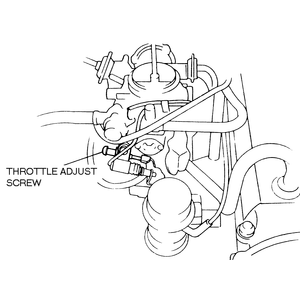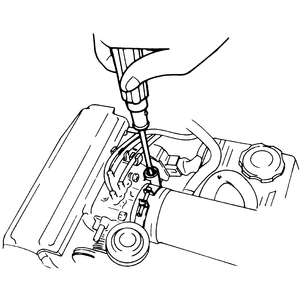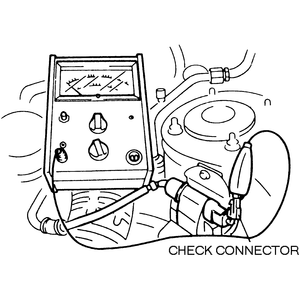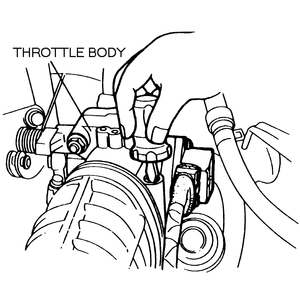Idle speed adjustments are easily accomplished, but you must be careful to
perform them under the proper conditions. The engine must be fully warmed up.
The best procedure is to drive the vehicle for several miles after the temperature
gauge indicates that the coolant has reached operating temperature. All normal
operating conditions should be maintained. For example, the air cleaner and
all vacuum hoses should be installed or connected, the choke should be wide
open, and all accessories should be off. This includes the engine cooling fan
if it is electrical. If necessary, unplug it. Also, avoid extremes of outside
temperature, and replace a thermostat that makes the engine operate too hot
or too cold before proceeding.
| Fig. 1: Disconnect the air bypass solenoid connector
when checking idle speed on a 1987 626 below sea level

|
| Fig. 2: Adjusting the idle speed on carbureted 323s — carbureted
GLC and 626 models similar

|
| Fig. 3: Adjusting the idle speed on fuel injected 323
models — 626 fuel injected models similar

|
On the 1978–79 GLC and 1979 626 models, disconnect the canister purge
hose between the canister and the air cleaner. On the 1986–87 626 and
MX-6, run the engine at 2,500–3,000 rpm in Neutral for three minutes before
proceeding.
- Warm up the engine to normal operating temperature and turn off all accessories.
- Connect a reliable tachometer according to tool manufacturer's instructions
(usually between the coil negative (−) terminal and ground).
- On 1987 626s only, disconnect the air bypass solenoid connector at altitudes
of less than 3,280 feet or 1,000 meters (sea level).
- Note the idle speed. Compare this reading to the appropriate range in the
Tune-Up Specifications chart located in this section.
NOTE: Read the tachometer's 4-cylinder scale, for both
rotary and piston engines. If the tachometer has only a 6-cylinder scale
and an 8-cylinder scale, read the 8-cylinder scale and multiply all readings
by two to get the correct rpm. For example, if the specified rpm is 700,
set the idle speed at 350 rpm, as indicated on the 8-cylinder scale.
- If the idle speed does not fall within the designated range, locate and
turn the appropriate idle speed adjusting screw until the desired reading
is attained:
- On carburetor-equipped engines, the throttle adjusting screw is usually
located on the lower portion of the carburetor near the throttle valve
shaft. The screw acts directly on a flange which is integral with the
throttle shaft; it does not actuate any cams or levers.
- On models equipped with electronic fuel injection, the air adjusting
screw is located on top of the throttle body.
- On 1986–87 323s, after adjusting the idle speed, the dashpot must
be adjusted as follows:
- Start the engine and warm it up to normal operating temperature.
- With the tachometer still connected, increase the engine speed to 3,000
rpm, then slowly reduce the engine speed and make sure the dashpot rod
contacts the lever at 2,400–2,600 rpm.
- If it does not operate as described, loosen the locknut and adjust the
rod by turning the dashpot.
- On 1987 626s, fasten the air bypass solenoid connector, if applicable.
- Disconnect and remove the tachometer.
The idle speed is controlled automatically by the Idle Speed Control (ISC)
solenoid valve, and adjustment is usually not necessary. However, if rough idling
occurs when pin 1 of the green test connector is grounded, then adjustment of
the idle speed is required. If adjustment is necessary, proceed as follows:
- Turn all of the vehicle's accessories to the off position, then connect
a tachometer to the engine check connector (see illustration).
| Fig. 4: Tachometer hooked up to the underhood check
connector — 929 shown

|
| Fig. 5: Idle speed adjustment for the 929 — other
models similar

|
- Warm up the engine to normal operating temperature.
- Ground pin 1 of the green test connector with a jumper wire. (An illustration
of this step is shown in the ignition timing portion of this section.)
- With the test connector grounded, check the idle speed. Compare this reading
to the Tune-Up Specifications chart located in this section. If it is not
within the specified range, remove the rubber cap from the air adjusting screw
on the throttle body and turn the screw to adjust the idle speed.
- Once the idle speed is within specification, install the cap and disconnect
the jumper wire from the test connector.
- On 1988 323s, after adjusting the idle speed, the dashpot must be adjusted
as follows:
- Start the engine and warm it up to normal operating temperature.
- With the tachometer still connected, increase the engine speed to 3,000
rpm, then slowly reduce the engine speed and make sure the dashpot rod
contacts the lever at 2,400–2,600 rpm.
- If it does not operate as described, loosen the locknut and adjust the
rod by turning the dashpot.
- Disconnect and remove the tachometer.



